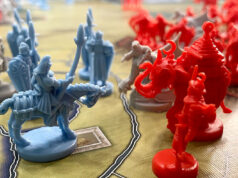Worker placement is one of the most common mechanisms in Euro games today. It allows for more than an average amount of player interaction as you compete over a limited number of spaces for each action.
The basic requirements for this list were: I’ve played it, you have one or more workers, and those workers compete for the same spots as your opponents. This excludes something like Scythe, which has been called worker placement, because your pawn is never blocked out my worker’s choices.
This list is also my favorite worker placement games. This tends to be on the heavier side of the gaming spectrum. I highly prioritize unique twists on the “normal” worker placement design.
Top 10 Worker Placement Board Games
10. Anachrony
 The newest entry on my list, Anachrony stands out in a number of ways. First off, it’s beautifully produced with optional sculpted miniatures. There are different types of workers and putting your workers on the “capital” requires an additional resource of an exosuit. And then there is a whole time travel element on top of that. I love that in Anachrony, each worker is not equal and the exosuits give you a further limit on how you can use the workers you have.
The newest entry on my list, Anachrony stands out in a number of ways. First off, it’s beautifully produced with optional sculpted miniatures. There are different types of workers and putting your workers on the “capital” requires an additional resource of an exosuit. And then there is a whole time travel element on top of that. I love that in Anachrony, each worker is not equal and the exosuits give you a further limit on how you can use the workers you have.
1-5 Players • Ages 15+ • 60-120 minutes • $70
9. Champions of Midgard
 Champions of Midgard is borderline to even be considered a Euro game. You chuck some dice around attempting to kill trolls and other monsters with your Viking horde. But you gather resources and recruit soldiers by using workers around the board prior to the battles taking place. It is a neat mash-up of Euro and Thematic mechanisms. And the fact that acquiring additional workers gets cheaper if you are the last one to do it, helps mitigate the common worker placement issue of rushing to get as many workers as possible as fast as possible.
Champions of Midgard is borderline to even be considered a Euro game. You chuck some dice around attempting to kill trolls and other monsters with your Viking horde. But you gather resources and recruit soldiers by using workers around the board prior to the battles taking place. It is a neat mash-up of Euro and Thematic mechanisms. And the fact that acquiring additional workers gets cheaper if you are the last one to do it, helps mitigate the common worker placement issue of rushing to get as many workers as possible as fast as possible.
2-4 Players • Ages 10+ • 60-90 minutes • $45
8. Alchemists (review)
 In Alchemists, you are trying to deduce what combination of ingredients makes various potions. This game uses an app to scan the ingredient cards to tell you the outcome of mixing those two particular items. While there is supposedly a way to play without an app, it requires hating someone and making them basically use a decoder ring to tell you the outcomes. One of the earliest app-assisted games, I love how it’s integrated into this game.
In Alchemists, you are trying to deduce what combination of ingredients makes various potions. This game uses an app to scan the ingredient cards to tell you the outcome of mixing those two particular items. While there is supposedly a way to play without an app, it requires hating someone and making them basically use a decoder ring to tell you the outcomes. One of the earliest app-assisted games, I love how it’s integrated into this game.
2-4 Players • Ages 13+ • 120 minutes • $50
7. Alien Frontiers
 Alien Frontiers replace your standard workers with dice. The value of the die can modify the action that is carried out in that space. There are technology cards that let you change your dice values often and allow for plenty of mitigation of bad luck with the dice. Dice placement, in general, is a nice change of pace from regular worker placement where you know exactly what you are going to get every time from your workers, and Alien Frontiers is the best of those games. The newest big box edition includes the many expansions and is a wonderfully produced game.
Alien Frontiers replace your standard workers with dice. The value of the die can modify the action that is carried out in that space. There are technology cards that let you change your dice values often and allow for plenty of mitigation of bad luck with the dice. Dice placement, in general, is a nice change of pace from regular worker placement where you know exactly what you are going to get every time from your workers, and Alien Frontiers is the best of those games. The newest big box edition includes the many expansions and is a wonderfully produced game.
2-4 Players • Ages 13+ • 90 minutes • $69
6. Manhattan Project: Energy Empire (review)
 The original Manhattan Project was one of my favorite board games I was introduced to when I started playing hobby board games. It was a little mean, but had a lot of interesting choices to make. Energy Empire has come and, although a very different game, probably will prevent me from getting the original off the shelf anytime soon. They both share the idea of taking a turn to recall your workers, which was an idea I really love in both games. In Manhattan Project: Energy Empire, the use of dice to gain energy, which can be used in addition or in place of workers, adds basically a new type of worker to the game. Energy can also be used to use a worker placement space that may have already been used by another player.
The original Manhattan Project was one of my favorite board games I was introduced to when I started playing hobby board games. It was a little mean, but had a lot of interesting choices to make. Energy Empire has come and, although a very different game, probably will prevent me from getting the original off the shelf anytime soon. They both share the idea of taking a turn to recall your workers, which was an idea I really love in both games. In Manhattan Project: Energy Empire, the use of dice to gain energy, which can be used in addition or in place of workers, adds basically a new type of worker to the game. Energy can also be used to use a worker placement space that may have already been used by another player.
1-5 Players • Ages 13+ • 60-120 minutes • $50
5. Agricola
 First off, I’m choosing Agricola over Caverna because I haven’t played Caverna, but I think the feeling works for both. These are both among the most popular worker placement games on the market. Agricola doesn’t stray far from normal worker placement mechanisms, but there is just a ton of variety in the box. The cards that you have available to you mean every game you will have to make some new choices about how to approach the game. And try not to starve your people while you are at it.
First off, I’m choosing Agricola over Caverna because I haven’t played Caverna, but I think the feeling works for both. These are both among the most popular worker placement games on the market. Agricola doesn’t stray far from normal worker placement mechanisms, but there is just a ton of variety in the box. The cards that you have available to you mean every game you will have to make some new choices about how to approach the game. And try not to starve your people while you are at it.
1-5 Players • Ages 12+ • 60-120 minutes • $50
4. The Gallerist
 I love the integration of the theme in The Gallerist. Regardless of what you think about the theme of running an art gallery, I personally love it, everything makes sense around that theme. You discover new artist. You can commission paintings from unknown artists and eventually help to make them more famous. You can sell works of art and the more famous the artist, the more money you’ll get. And of course, you can promote artists in the media to help raise their exposure. Despite the weight and complexity of The Gallerist, it’s easy to teach because it all makes sense. The Gallerist is also beautiful, as you might expect a game about art to be. You have only a single worker and while other players can’t block you from a space entirely, if you bump them out they get an extra action. It’s a cool twist as you have to balance your own inefficiency against helping out other players.
I love the integration of the theme in The Gallerist. Regardless of what you think about the theme of running an art gallery, I personally love it, everything makes sense around that theme. You discover new artist. You can commission paintings from unknown artists and eventually help to make them more famous. You can sell works of art and the more famous the artist, the more money you’ll get. And of course, you can promote artists in the media to help raise their exposure. Despite the weight and complexity of The Gallerist, it’s easy to teach because it all makes sense. The Gallerist is also beautiful, as you might expect a game about art to be. You have only a single worker and while other players can’t block you from a space entirely, if you bump them out they get an extra action. It’s a cool twist as you have to balance your own inefficiency against helping out other players.
1-4 Players • Ages 13+ • 60-120 minutes • $80
3. Keyflower
 Keyflower is far from a traditional worker placement game. The workers you have available to you are used to bid on tiles, but also to activate those tiles during production. There is a careful balance; if you use all your workers to acquire tiles you won’t be able to activate everything you need to. You can even activate tiles that other players acquire, but those workers will go to them at the end of the round. However, workers come in a variety of colors and each tile can only have one color of worker on it. So you can attempt to lock other players out of using a tile, even their own, by placing workers of a color they may not have available. Workers are hidden though, so you may not know exactly what each player can do.
Keyflower is far from a traditional worker placement game. The workers you have available to you are used to bid on tiles, but also to activate those tiles during production. There is a careful balance; if you use all your workers to acquire tiles you won’t be able to activate everything you need to. You can even activate tiles that other players acquire, but those workers will go to them at the end of the round. However, workers come in a variety of colors and each tile can only have one color of worker on it. So you can attempt to lock other players out of using a tile, even their own, by placing workers of a color they may not have available. Workers are hidden though, so you may not know exactly what each player can do.
2-6 Players • Ages 12+ • 90-120 minutes • $60
2. Viticulture (review)
 Viticulture falls into a similar category as The Gallerist. The integration of the theme really draws you into the game and makes easy to get into. The addition of the “grande” worker is a simple, but neat innovation. This worker can go to an area even if it is filled by other players. So the blocking you can do it mitigated, but you only have one grande worker so you have to use them carefully. This cuts down on the frustration of being blocked, but doesn’t eliminate the tension entirely. Viticulture is best played with the extended board from the Tuscany expansion. It adds more interest to the bidding for turn order at the opening of each round and gives you more to do each season. There is also an added element of timing, being the first to pass during the last season lets you bid first. Viticulture is approachable and yet has a lot of depth of strategy.
Viticulture falls into a similar category as The Gallerist. The integration of the theme really draws you into the game and makes easy to get into. The addition of the “grande” worker is a simple, but neat innovation. This worker can go to an area even if it is filled by other players. So the blocking you can do it mitigated, but you only have one grande worker so you have to use them carefully. This cuts down on the frustration of being blocked, but doesn’t eliminate the tension entirely. Viticulture is best played with the extended board from the Tuscany expansion. It adds more interest to the bidding for turn order at the opening of each round and gives you more to do each season. There is also an added element of timing, being the first to pass during the last season lets you bid first. Viticulture is approachable and yet has a lot of depth of strategy.
2-6 Players • Ages 13+ • 90 minutes • $45
1. Kanban
 Similar to The Gallerist (and also designed by Vital Lacerda), in Kanban you only have a single worker at your disposal. Yet Kanban feels most tense in terms of keeping an eye on where other players are going. Each area has two action spaces, the leftmost space will activate first, but provides lets you do less actions that turn. There is almost a press your luck element in deciding if you can afford to take the additional action knowing another player could go before you and ruin your plans. You also have to deal with your boss, Sandra, moving around the board and docking you points if you aren’t progressing far enough. You constantly want to stay ahead of Sandra while still getting the cars, parts, and designs you need to earn points. The fact that the action spaces activate left-to-right and you choose your spot from the next round in the same order means that even in a two player game the options feel extremely tight. Kanban is a heavy game with a lot going on and my favorite take on worker placement.
Similar to The Gallerist (and also designed by Vital Lacerda), in Kanban you only have a single worker at your disposal. Yet Kanban feels most tense in terms of keeping an eye on where other players are going. Each area has two action spaces, the leftmost space will activate first, but provides lets you do less actions that turn. There is almost a press your luck element in deciding if you can afford to take the additional action knowing another player could go before you and ruin your plans. You also have to deal with your boss, Sandra, moving around the board and docking you points if you aren’t progressing far enough. You constantly want to stay ahead of Sandra while still getting the cars, parts, and designs you need to earn points. The fact that the action spaces activate left-to-right and you choose your spot from the next round in the same order means that even in a two player game the options feel extremely tight. Kanban is a heavy game with a lot going on and my favorite take on worker placement.
2-4 Players • Ages 12+ • 90-120 minutes • $40























I would have liked to see Lords of Waterdeep make the list
Personally I’d place Lords of Waterdeep and Russian Railroads above a few of these but otherwise, nice list.
I agree with you on Russian Railroads. Hard to argue against that game.
Fields of Arle, Egizia, Dungeon Petz, and +1 for Russian Railroads.
Argent! 🙂
Would Pandemic be considered a collaborative worker placement game? Are there other collaborative worker placement games?
Julien – the thing about definitions of board game mechanisms… everyone defines them differently.
Personally, I would say no, co-op and worker placement don’t really coexist well. And the reason is that a key feature of worker placement is blocking spaces from your opponents.
That said, I’m sure there is some example out there that is close, but I don’t know what it would be.